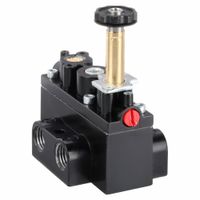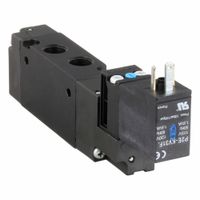Call +(254) 703 030 000 / 751 483 999 / 721 704 777
- Home
- Pneumatics
- Pneumatic Valves
- Inline Air Control Valves
- Solenoid Operated Inline Air Control Valves
.....Read More
Frequently Asked Questions
What are solenoid-operated inline air control valves?
Solenoid-operated inline air control valves are electromechanical devices used to control the flow of air in pneumatic systems. These valves utilize a solenoid, which is a coil of wire that acts as an electromagnet when an electric current passes through it. The solenoid is responsible for actuating the valve mechanism, allowing for precise control over the air flow.
The inline design of these valves means they are installed directly in the air line, allowing for a streamlined and efficient setup. When the solenoid is energized, it creates a magnetic field that moves a plunger or armature within the valve. This movement opens or closes the valve, thereby controlling the passage of air through the system.
Solenoid-operated inline air control valves are commonly used in various industrial applications, including automation, manufacturing, and process control. They offer several advantages, such as rapid response times, high reliability, and the ability to be remotely controlled. These valves can be configured for different functions, such as normally open or normally closed, depending on the specific requirements of the application.
The materials used in these valves are typically chosen for durability and compatibility with the operating environment, often including metals like brass or stainless steel and elastomers for seals. The valves can handle a range of pressures and flow rates, making them versatile for different pneumatic systems.
Overall, solenoid-operated inline air control valves are essential components in modern pneumatic systems, providing efficient and reliable control of air flow with the convenience of electrical actuation.
How do solenoid-operated inline air control valves work?
Solenoid-operated inline air control valves function by using an electromagnetic solenoid to control the flow of air through a valve. When electrical current passes through the solenoid coil, it generates a magnetic field that moves a plunger or armature within the coil. This movement opens or closes the valve, allowing or stopping the flow of air.
The valve typically consists of a solenoid coil, a plunger, a spring, and a valve body with ports for air entry and exit. In a normally closed valve, the spring holds the plunger against the valve seat, preventing air flow. When the solenoid is energized, the magnetic field pulls the plunger away from the seat, opening the valve and allowing air to pass through. Conversely, in a normally open valve, the plunger is held away from the seat by the spring, and energizing the solenoid moves the plunger to close the valve.
These valves can be direct-acting or pilot-operated. Direct-acting valves use the solenoid to directly move the plunger, suitable for low-flow applications. Pilot-operated valves use the solenoid to control a smaller pilot valve, which in turn controls a larger main valve, suitable for higher flow rates.
Solenoid-operated inline air control valves are used in various applications, including pneumatic systems, automation, and process control, due to their fast response time, reliability, and ease of integration with electronic control systems. They offer precise control over air flow, pressure, and direction, making them essential components in many industrial and commercial systems.
What are the benefits of using solenoid-operated inline air control valves?
Solenoid-operated inline air control valves offer several benefits:
1. **Precision and Control**: These valves provide precise control over airflow, allowing for accurate regulation of pressure and flow rates in pneumatic systems. This precision enhances the performance and efficiency of the system.
2. **Automation**: Solenoid valves can be easily integrated into automated systems, enabling remote operation and control. This automation reduces the need for manual intervention, increasing operational efficiency and reducing labor costs.
3. **Fast Response Time**: Solenoid valves have a rapid response time, which is crucial in applications requiring quick actuation. This speed enhances the performance of dynamic systems, such as those in manufacturing and processing industries.
4. **Compact Design**: The compact size of solenoid-operated valves makes them ideal for applications with space constraints. Their small footprint allows for easy installation in tight spaces without compromising functionality.
5. **Energy Efficiency**: These valves consume power only during the actuation process, making them energy-efficient. This efficiency can lead to cost savings, especially in systems that require frequent valve operation.
6. **Reliability and Durability**: Solenoid valves are known for their reliability and long service life. They are designed to withstand harsh operating conditions, reducing maintenance needs and downtime.
7. **Versatility**: Available in various configurations and materials, solenoid-operated valves can be used in a wide range of applications, from industrial automation to HVAC systems, accommodating different media and environmental conditions.
8. **Safety**: The ability to quickly shut off or redirect airflow enhances safety in systems where rapid response to changes is critical, such as in emergency shutdown procedures.
Overall, solenoid-operated inline air control valves offer a combination of precision, efficiency, and reliability, making them a valuable component in modern pneumatic systems.
How do I choose the right solenoid-operated inline air control valve for my system?
1. **Understand System Requirements**: Determine the flow rate, pressure, and temperature requirements of your system. This will help in selecting a valve that can handle the specific conditions.
2. **Valve Type**: Choose between normally open or normally closed valves based on whether you want the valve to default to open or closed when de-energized.
3. **Size and Flow Capacity**: Select a valve with the appropriate port size and flow coefficient (Cv) to ensure it can handle the required air flow without causing pressure drops.
4. **Material Compatibility**: Ensure the valve materials are compatible with the air and any other substances it may come into contact with to prevent corrosion or degradation.
5. **Voltage and Power**: Match the solenoid valve’s voltage and power requirements with your system’s electrical supply to ensure proper operation.
6. **Response Time**: Consider the response time of the valve, especially if your application requires quick actuation.
7. **Environmental Conditions**: Choose a valve that can withstand the environmental conditions it will be exposed to, such as moisture, dust, or extreme temperatures.
8. **Certification and Standards**: Ensure the valve meets any industry-specific standards or certifications required for your application.
9. **Maintenance and Reliability**: Consider the ease of maintenance and the reliability of the valve, especially if it will be used in a critical application.
10. **Cost and Availability**: Balance the cost of the valve with its features and availability to ensure it fits within your budget and timeline.
11. **Manufacturer Reputation**: Choose a reputable manufacturer known for quality and support to ensure long-term reliability and service.
What brands offer solenoid-operated inline air control valves?
1. **Festo**: Known for its automation technology, Festo offers a wide range of solenoid-operated inline air control valves suitable for various industrial applications.
2. **SMC Corporation**: A leading manufacturer of pneumatic components, SMC provides a comprehensive selection of solenoid valves designed for efficient air control.
3. **Parker Hannifin**: Parker's extensive product line includes solenoid-operated air control valves that cater to diverse industrial needs, ensuring reliability and performance.
4. **Norgren**: Part of the IMI Precision Engineering group, Norgren offers high-quality solenoid valves that are designed for precision and durability in air control applications.
5. **ASCO (Emerson)**: ASCO, a brand under Emerson, is renowned for its solenoid valves that are engineered for a wide range of air control applications, providing robust and reliable solutions.
6. **Bosch Rexroth**: This brand offers a variety of solenoid-operated valves that are designed for efficient air control in industrial automation systems.
7. **Humphrey Products**: Specializing in pneumatic and fluid control products, Humphrey provides solenoid valves that are suitable for various air control applications.
8. **Bürkert**: Known for its fluid control systems, Bürkert offers solenoid valves that are designed for precise air control in various industrial processes.
9. **Clippard**: Clippard's range of solenoid valves includes options for inline air control, known for their compact design and reliable performance.
10. **Numatics (Emerson)**: Another brand under Emerson, Numatics offers a wide range of solenoid-operated valves for efficient air control in automation systems.
11. **Koganei**: This Japanese company provides a variety of solenoid valves that are designed for effective air control in different industrial applications.
12. **Aventics (Emerson)**: Aventics, also part of Emerson, offers solenoid valves that are engineered for precision and efficiency in air control systems.
How do I install a solenoid-operated inline air control valve?
1. **Select the Valve**: Choose a solenoid-operated inline air control valve suitable for your application, considering factors like pressure, flow rate, and voltage.
2. **Gather Tools and Materials**: You will need wrenches, Teflon tape, electrical connectors, and possibly a drill and mounting hardware.
3. **Safety Precautions**: Turn off the air supply and disconnect electrical power to prevent accidents.
4. **Prepare the Installation Site**: Identify the section of the air line where the valve will be installed. Ensure the area is clean and accessible.
5. **Cut the Air Line**: Use a pipe cutter to cut the air line at the desired location. Ensure the cut is clean and straight.
6. **Install the Valve**:
- Wrap Teflon tape around the threads of the valve to ensure a tight seal.
- Connect the valve to the air line using appropriate fittings. Ensure the valve is oriented correctly, following the flow direction indicated on the valve body.
- Tighten the connections with a wrench, but avoid over-tightening to prevent damage.
7. **Mount the Valve**: Secure the valve to a stable surface using mounting brackets or hardware, if necessary, to prevent movement and vibration.
8. **Electrical Connection**:
- Connect the solenoid to the power supply using appropriate electrical connectors.
- Ensure the voltage and current ratings match the solenoid specifications.
- Secure the wiring to prevent loose connections.
9. **Test the Installation**:
- Restore the air supply and electrical power.
- Check for leaks by applying soapy water to the connections and observing for bubbles.
- Test the valve operation by activating the solenoid and ensuring proper function.
10. **Final Adjustments**: Make any necessary adjustments to the valve settings or connections to ensure optimal performance.
What maintenance is required for solenoid-operated inline air control valves?
1. **Regular Inspection**: Check for physical damage, corrosion, or wear on the valve body, solenoid coil, and electrical connections. Ensure all components are securely fastened.
2. **Cleaning**: Remove dust, dirt, and debris from the valve and surrounding area. Clean the solenoid coil and valve internals to prevent blockages and ensure smooth operation.
3. **Lubrication**: Apply appropriate lubricants to moving parts as recommended by the manufacturer to reduce friction and wear.
4. **Electrical Connections**: Inspect and tighten electrical connections. Check for signs of overheating or corrosion. Ensure the solenoid coil is receiving the correct voltage.
5. **Seal and Gasket Inspection**: Examine seals and gaskets for wear or damage. Replace if necessary to prevent leaks and maintain pressure integrity.
6. **Functionality Testing**: Regularly test the valve's operation by cycling it on and off. Listen for unusual noises and ensure it opens and closes smoothly.
7. **Pressure and Flow Check**: Verify that the valve maintains the correct pressure and flow rates. Adjust settings if necessary to meet system requirements.
8. **Leak Detection**: Use soapy water or a leak detection solution to check for air leaks around connections and seals.
9. **Coil Resistance Check**: Measure the resistance of the solenoid coil with a multimeter to ensure it is within the specified range.
10. **Replacement of Worn Parts**: Replace any worn or damaged parts, such as springs, diaphragms, or solenoid coils, to prevent failure.
11. **Documentation**: Keep detailed records of maintenance activities, including dates, findings, and actions taken, to track the valve's condition over time.
12. **Manufacturer Guidelines**: Follow the manufacturer's maintenance schedule and guidelines for specific procedures and intervals.


